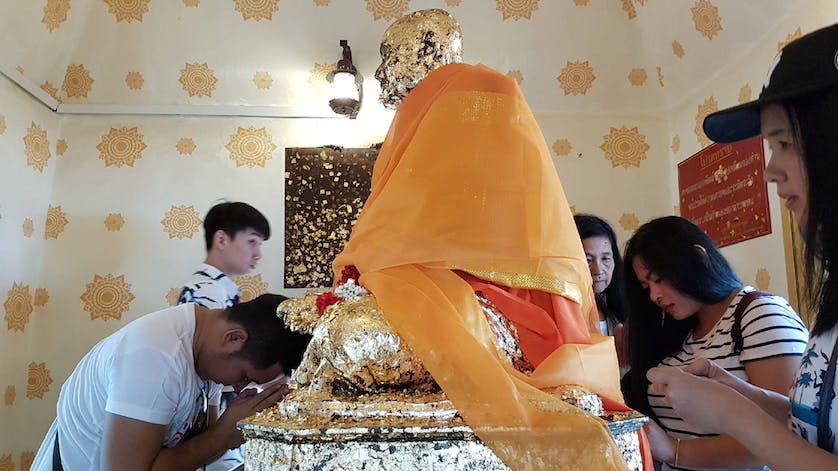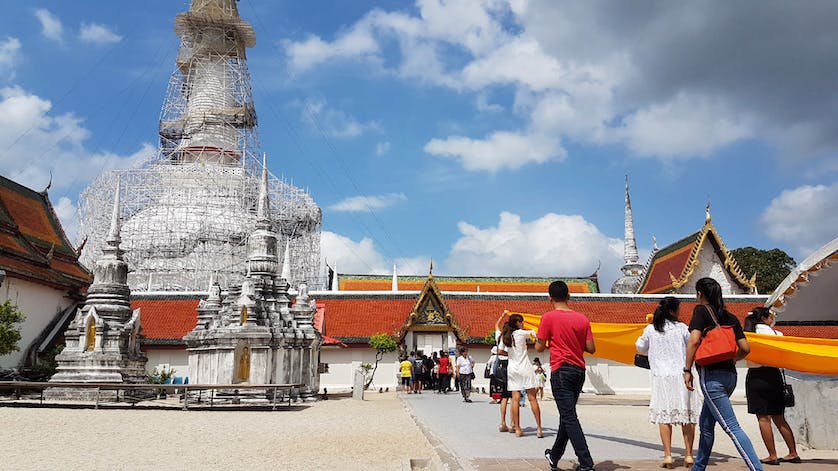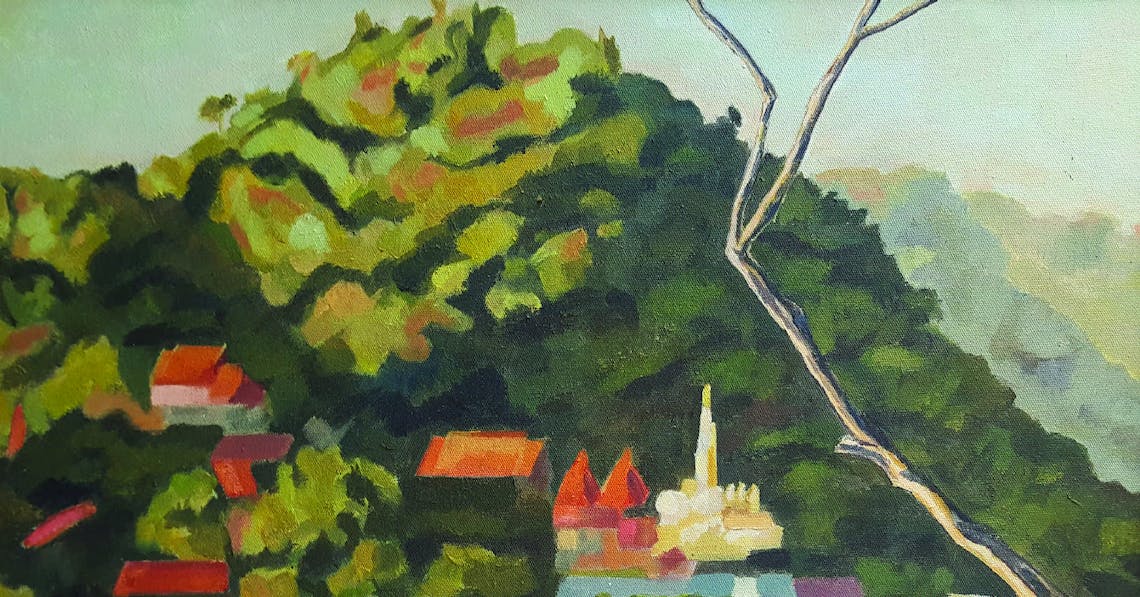On the morning of this year’s Asanha Bucha Day, Pat prepared an assortment of delicacies and necessities, packing them into a basket with a big jaunty bow and corralled her family into a car to drive to Wat Pong Yang Chalerm Phra Kiet in Mae Rim to make merit.
On arrival at the glitzy gilded complex, where a large standing Buddha built by HM King Rama X stood by a giant sleeping Buddha under construction by orders of a royal princess, set amongst numerous opulent buildings and halls boasting plaques attesting to the largess of one police or army general after another, Pat parked her car and tried to ascertain as to which of the dozens of gleaming buildings would house a monk who would accept her basket of goodies in exchange for a blessing or two.
After wandering the complex for a good half hour and seeing no one, she came across a caretaker who informed her that there were only three resident monks at the temple, all of whom were currently abroad where they spent most of the year. She was referred to a jungle monastery up the road where she found dozens of monks meditating in humble — plaque-free — homes who were very grateful for the donation and happy to chant some blessings for her efforts, ending up spending hours talking Buddhist philosophy with the abbot.
“Temples used to be the heart of every Thai community,” said Assoc. Prof. Dr. Apinya Fuengfusakul, Faculty of Social Science, Chiang Mai University. “They were schools for children, hotels for travellers, venues for community events, and the monks acted as counselor and mediator, even healers. Young boys and girls would come to temple fairs where they would flirt and fall in love and old people would congregate in the temple to socialise and help out. It was the soul of the village. Today, you see more and more empty temples, yet they are more often than not richer than they have ever been. Temples no longer have a social function within the communities they serve yet they have turned into impressive looking ornaments, funded by the faithful, if not devout.”
“There are many strategies as to how Buddhism is adapting to modern life.”
There is widespread disenfranchisement among many Thais, especially the younger generations, who can no longer identify nor relate to the Buddhism of their parents and grandparents. While many don’t go so far as to renounce the religion, they have no active participatory role, they do not follow the basic Five Precepts and unlike Thai Buddhists of yore, religion is not an integral part of their daily lives. While it was the norm for nearly every Buddhist Thai man (95% of the population is Buddhist) to become ordained, traditionally for at least three months during Buddhist Lent, today’s numbers of monks in Thailand have less than halved in the past three decades, with only approximately 298,000 monks and 60,000 novices practicing at any given time. Most of these are not career monks, some ordaining for as short a time as one day, leaving Thailand’s 39,883 temples mostly empty…if well-funded.
“The Buddha was wise,” said Dr. Apinya. “He took economic temptation away from monks by having them ask for alms, this was to both free monks from such prosaic activities as working but also to imbue in them a sense of humility by reducing the ego, allowing them to focus solely on the spiritual. But that seems to have all been ignored today and the religion itself has turned into a cog in the economic engine of Thailand.”
The Disconnect
“The role of Buddhism in the past went way beyond belief,” explained Dr. Apinya. “It had a strong social function and set structures to control and manage society and family, from the culture of sex to inheritance roles. Buddhism and mysticism went hand in hand, connecting communities and those who shared resources, acting as a language of sorts that helped to keep the social balance and social systems, even our relationship with nature, in harmony. So when King Rama V created the 1902 Sangha Law as part of his efforts to consolidate and centralise the nation, bringing Buddhism into the fold of the state, all those roles ceased to exist. Schools took the children, hospitals the sick, discotheques the flirting teens and hotels the weary. Suddenly temples no longer had relevancy.”
In the early 20th century when the sangha (monastic community) became part of the state apparatus, it implemented an ecclesiastic hierarchy. Whereas in the past monks meditated to gain wisdom and insight, such abstract practices were unquantifiable in the new system and for monks to advance in title and seniority, they were measured by their study and recitation of scripts as well as how much donation they generated for their temple. “The elite of Thailand were western educated in those days,” continued Dr. Apinya, “and they found that meditation wasn’t empirical. They wanted monks’ education to be more secular. Studying Pali and Sanskrit scripts was measurable, but this was empty learning, rote learning and not wisdom. How can you be a spiritual leader when you don’t know how to meditate?”
At the same time the system changed to appointing abbots from Bangkok rather than being locally chosen by the village, further disconnecting the temples from their surrounding villagers who would no longer be involved with their temples, yet whose children would donate money, sent from their jobs in big cities to build gilded pagodas and ubiquitous plaques.

Buddhism 2.0
The Sangha Supreme Council, the governing body of the Buddhist order, is the ultimate authority for all things monastic in Thailand, yet most lay Buddhists know little about its inner workings — not even the name of the Supreme Patriarch. Instead, we read about one scandal after another in the media, of abbots, monks and novices engaging in corruption, sex scandals, crime, drug and human trafficking and even murder. The silence from the Sangha Supreme Council is deafening. The nearly fossilised body of mostly very old men out of touch with today’s world, having atrophied through inertia into a weak, inefficient and ineffective organisation, seemingly only take conservative stands on any social issues, such as the ordination of women, which it has banned.
As Thailand’s economy has grown exponentially over the past two generations with materialism and consumerism appearing to be the nation’s new opiate of choice, the Sangha has failed to adjust to the reality of the new world, losing its relevance day by day. Those seeking spiritual guidance or comfort on a higher plain are therefore facing a multitude of new choices, hybrids if you will, of the traditional Thai Theravada Buddhism. And there is no shortage of people and organisations stepping up, from the pure intentioned to the wicked, to take advantage of such vulnerabilities, and deep pockets.
Shopping for Belief
“Wat Phra Dhammakaya under the leadership of Luang Por Dhammajayo is one of the most famous working temples in Thailand today,” explained an academic who wishes to remain anonymous. “This is a religious sect which has merged economic values with religion. They say that there is nothing wrong with commercialising and commoditising Buddhism, in fact they take great pride in it, because they say that to fail to embrace today’s values is to weaken the role of religion. They legitimise their aggressive marketing and brilliant direct sales strategies by claiming that it strengthens Buddhism, going so far as to take great pride in winning the Marketing Plan of Thailand,” a stratagem which has succeeded in turning the abstract into coin. A lot of coin.
It is estimated that Thailand’s temples receive over 100 billion baht in donations each year, according to the National Institute of Development Administration, receiving an additional 3.4 billion baht a year in state funding for temple renovations. And yet it was only in 2015 that temples were made to publish their financial statements, for decades vast sums of money donated being utterly unaccounted for and often abused by the unscrupulous, whether monks or those surrounding them.
“For those who reject these consumerist values, they have other options,” continued the academic who went on to talk about the Santi Asoke sect which takes a radical sectarian approach to the more traditional forest monks’ simplistic ideals. “They are all about abstinence and are staunchly anti-consumerist. Their members follow the Five Precepts, wear basic natural dye clothes and live simple communal lives cultivating alternative crops. Their collectives sell some of the best quality produce, coveted by many for their organic and high value properties, all sold at lower than cost price, their combined assets subsidising what they call ‘giving back to society’.”
“Buddhism and mysticism went hand in hand.”
Unlike many other sects, Santi Asoke is very active politically. One devout follower, Chamlong Srimuang founded the Palang Dharma political party in 1988, going on to be prime minister. Many senior members were also vocal supporters of the Yellow Shirt movement. “They want to slap consumerism in the face,” continued the academic. “They say they don’t play politics, they do politics. They believe that society is corrupted to its roots and say that they can’t simply sit under a tree with closed eyes, that they have a prerogative, a mission, to save society. These are the people behind much of the conservative social lobbying.”
“Those of us who are seeking a more intellectual interpretation of Buddhism follow leaders such as last century’s Buddhadasa Bhikkhu who rejected ritualism and politics which has ensnared Thailand’s Buddhism. Buddhadasa believed that at its core, all religions were the same and preached a rationalist interpretation to personal spiritual growth, reinterpreting the traditional views of reincarnation, for instance. He passively fought against and rejected the ecclesiastical hierarchy and believed that religion should stand above and not be part of the state apparatus. It is these types of forest monks who are now appealing to not just the intellectual, but western spiritual seekers. As the west embraces rationality and science, many seek spiritual anchors, and while they reject the trappings of Buddhism, they embrace its core philosophies, seeing it not as a ritual as we Thais do, but as a way of life, as we used to.”
There are currently over 200 registered meditation centres across Thailand, most with long admission queues and many using modern technology such as the internet for bookings and other business. While they promote the traditional interpretations of Buddhism, they have adapted to the modern world in terms of tools and delivery.
As various sects of Christianity splintered off from the Vatican over the centuries, new sects meeting the different needs of the diverse populations across Europe and beyond, so is Buddhism facing a similar fracturing here in Thailand.
“So, you see,” he continued, “there are many strategies as to how Buddhism is adapting to modern life.”

Magic, Mysticism and Money
With such a plethora of choice, Buddhists are now able to pick and choose the religion of their liking, each following or taking away a different aspect of the religion.
“If you are a rich Khun Ying who likes to meditate in air-conditioned comfort,” he explained, “then you embrace Dhammakaya. If you are a poor farmer with debts and want to start your life fresh and debt-free, then maybe Santi Asoke is your sect of choice. Those who are seeking personal spiritual growth can go to any number of intelligent forest monks to soothe the soul and if you are simply wanting a shortcut to riches, well then the choices are endless.”
With Thailand’s recent mass embourgeoisement, materialism is the new national doctrine. Monks act more as blessers of good fortune than spiritual guides. Most monks spend their days not in meditation or prayer, but receiving cash payments for blessing new businesses, new cars and new homes. Temples feature lottery sales, coin-operated fortune dispensers and for a few baht a monk can even churn out a new, and more auspicious, name for you on his laptop. For many millions who still call themselves Buddhist but no longer practice it in their daily lives, they can assuage any guilt they may have by making merit, often in forms of donating to a famous temple or monk in the belief that the more auspicious the recipient, the more karma credit their baht will stretch them.
“Forest monks, while focused on meditation,” explained the academic, “have historically also claimed transcendental powers such as the ability to levitate, see the future or walk on water. Villagers seek these powers while often rejecting the preaching which comes with it. The power is often sought to cure illnesses, bring fortune or attract love, but these same people who go and ask a monk to pick a lottery ticket or stand on a banknote for good luck are disinterested in or unable to follow the more strict guidelines of Buddhism: they drink, they have recreational sex, they harm living things, they take what is not given freely, they lie and they gossip. They are more interested in what they can get out of the religion than in practicing it. That is why it is a common sight to see a temple with an alter featuring a Hindu Ganesh, a Mahayana Guan Yin, or even a statue of Jesus. The cultural pluralism, fed by modern media, has blurred the borders of religion which is now just taken and consumed.”
“People can shop for their own version of religion.”
He calls this the 7-Eleven of religion, or prosperity religion. It is a convenient culture of belief which mixes faith, magic, lore and pure wishful thinking into easily consumed bites. While she, unlike the Sangha Supreme Council, doesn’t feel threatened by these modern manifestations of Buddhism, she does express concern over the “vulgarisation of Buddhism” where every facet of faith is seen through the lens of money.
“Even ghosts have been commodified,” he laughs, explaining about a popular TV Show which invites a panel of ‘experts’ to help women who have had abortions, often shunned by society, to share their stories and seek forgiveness from their expelled foetuses, often by making merit or paying for ceremonies.
Sifting through the Detritus
Many young Thais today no longer feel that Buddhism meets their needs. There is a kind of intellectual derision towards religion and a feeling that it is there not to help but to tame. They feel contempt towards a religion so ill-suited to their daily needs, especially one riddled with corruption and hypocrisy. More and more these people will stick to their own moral yardstick, finding their own spiritual path whether it is to join an NGO or do volunteer work. The good news, according to Dr. Apinya, is that there are many people who are studying Buddhism and attempting to find a way to interpret it towards relevance again.
“There is choice,” he concluded. “Buddhism has now adapted and adjusted to meet different tastes, needs, prejudices and world views. People can shop for their own version of religion. It is very lively and full of conflict, but there are choices and a great diversity in addressing big issues such as afterlife, sin and merit. The formal authorities have lost their position of leadership of the soul, but there are many interesting new sects on the rise.”
Pat won’t be visiting the sparkling temple on the hill again as she sees it as a mere shell and symbol of Buddhism. But she, like many other Thai Buddhists, has found an alternative destination to soothe her soul.
Related Articles
